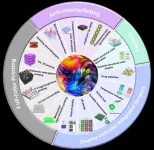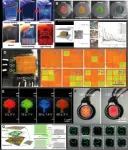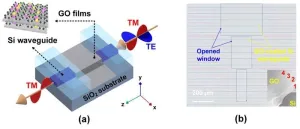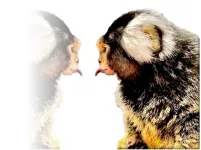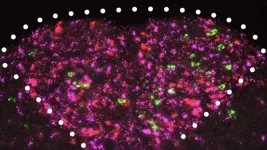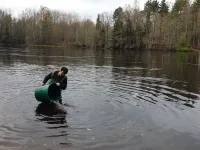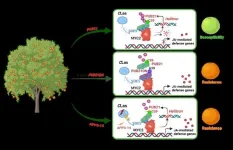A new publication from Opto-Electronic Sciences; DOI 10.29026/oes.2025.240030, discusses unlocking the vibrant photonic realm.
Nature not only provides humans with abundant material resources but also offers rich colors, satisfying both material and spiritual needs. The vibrant and diverse colors displayed by peacock feathers, opals, and beetles are all a result of the exquisite structural colors found in nature. The micro- and nanostructures on their surfaces interact with light, producing phenomena such as diffraction, scattering, interference, and selective reflection, thereby exhibiting vivid and bright color characteristics. By emulating the photonic structures that generate structural colors in nature, we can artificially construct micro- and nanostructures and design ordered configurations to regulate the transmission and response behavior of light waves. This utilization of the interaction between light and matter has enabled the application of structural colors in various aspects of life, including colorful decorations, anti-counterfeiting, printing, and sensing. In summary, structural colors, characterized by their high stability, durability, and environmental friendliness, have become a promising alternative to traditional coloring methods.
This review focuses on the applications of structural colors in the fields of anti-counterfeiting, display technology, sensors, and printing (Fig. 1). Firstly, it discusses and compares various fabrication methods for structural colors, providing design guidance for selecting suitable structural colors for different application scenarios. Secondly, the article dissects the physical mechanisms behind the emergence of structural colors and their design principles in micro/nano photonics. A comparative analysis of five typical structural coloration principles is presented, highlighting their individual advantages and limitations. This critical evaluation aims to streamline the transition from conceptual design to practical application. Subsequently, the review delves into the emerging applications of structural colors, ranging from artificial structures to colloidal crystals. Guided by practical applications, it showcases the versatility of current design strategies and their ability to meet a broad array of functional demands.
In the realm of structural color fabrication, the evolution can be categorized from one-dimensional (1D) to three-dimensional (3D) structures, and the manufacturing methods can be divided into bottom-up, top-down, and hybrid approaches. These include metasurfaces, photonic crystals, Fabry-Perot cavities, plasmonic resonances, and colloidal photonic crystals. Metasurfaces, as representatives of structural colors, offer high color tunability, large information density, and multiple color channel dimensions, and are widely used in anti-counterfeiting and printing, as shown in Fig. 2. Colloidal photonic crystals, as typical representatives of bottom-up structural colors, can develop a range of responsive structural color devices, such as those responsive to force, magnetism, heat, and electricity, enabling dynamic structural color displays, as illustrated in Fig. 3.
The review introduces the recent developments in the field of structural color, discusses the current mainstream application scenarios, and indicates that future development should focus on the development of intelligent structural color devices, the establishment of micro/nano structure databases, the improvement of the closed-loop chain from design to processing, and the expansion of structural color application scenarios.
This work was financially supported by the Natural Science Foundation of Shaanxi Province (Grant No. 2024JC-YBMS-291); Special Support Program for High-level Talents of Shaanxi Province (No. 2020-44). The authors thank Wenhui Dou (Rocket Force University of Engineering) for offering language support.
Keywords: structural color / metasurface / photonic crystals / dynamic tunable
# # # # # #
Long Wang, is an associate professor and doctoral supervisor at the Zhijian Laboratory of the Rocket Force University of Engineering. His main research and teaching focus on photothermal regulation technology, intelligent materials and structures, and advanced manufacturing technology. He has published more than 110 academic papers, authored and co-authored 4 books and textbooks, filed more than 90 invention patents (with 51 authorized patents), and obtained 9 software copyrights.
Xiaohu Wu primarily focuses on research in the fields of radiative heat transfer, solar-thermal utilization, and micro/nano photonics, having published over 200 academic papers. His research work was selected as one of the American Optical Society’s 30 global optical advancements in 2020 and has received the Hartnett-Irvine Award from the International Center for Heat and Mass Transfer. He has presided over 4 scientific research projects at the national and Shandong provincial levels. He holds 3 authorized invention patents, 5 software copyrights, and has published one 1 English monograph. Xiaohu Wu founded the WeChat public account “Thermal Radiation and Micro/Nano Photonics,” dedicated to academic sharing and dissemination.
Prof. Youju Huang established the Key Materials Team for Nanobiosensors in September 2019, focusing on the core materials and key scientific issues in nanobiosensors. The team has developed a series of novel nanobiosensing technologies and explored their fundamental research and industrialization in in vitro medical diagnostics. The team has published over 200 papers in internationally renowned SCI journals. The team leader has published more than 150 papers in journals such as Chemical Society Reviews, Science Advances, Advanced Materials, Advanced Functional Materials, ACS Nano, Biomaterials, and Analytical Chemistry.
# # # # # #
Opto-Electronic Science (OES) is a peer-reviewed, open access, interdisciplinary and international journal published by The Institute of Optics and Electronics, Chinese Academy of Sciences as a sister journal of Opto-Electronic Advances (OEA, IF=15.3). OES is dedicated to providing a professional platform to promote academic exchange and accelerate innovation. OES publishes articles, reviews, and letters of the fundamental breakthroughs in basic science of optics and optoelectronics.
# # # # # #
More information: https://www.oejournal.org/oes
Editorial Board: https://www.oejournal.org/oes/editorialboard/list
OES is available on OE journals (https://www.oejournal.org/oes/archive)
Submission of OES may be made using ScholarOne (https://mc03.manuscriptcentral.com/oes)
CN 51-1800/O4
ISSN 2097-0382
Contact Us: oes@ioe.ac.cn
Twitter: @OptoElectronAdv (https://twitter.com/OptoElectronAdv?lang=en)
WeChat: OE_Journal
# # # # # #
Wang WH, Wang L, Fu QQ et al. Structural color: an emerging nanophotonic strategy for multicolor and functionalized applications. Opto-Electron Sci x, 240030 (2025). doi: 10.29026/oes.2025.240030
END
